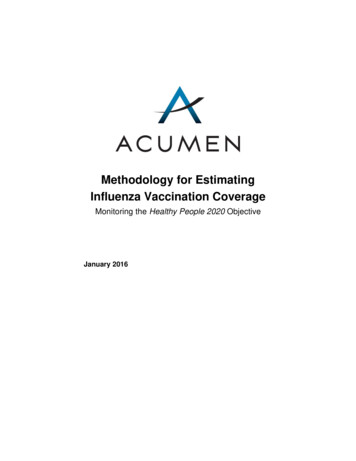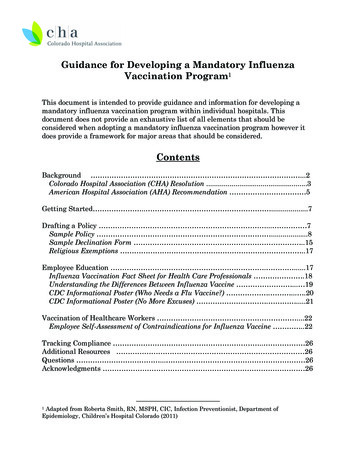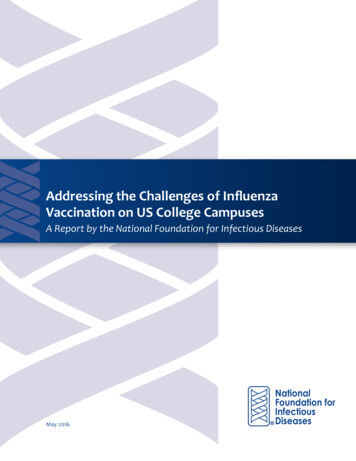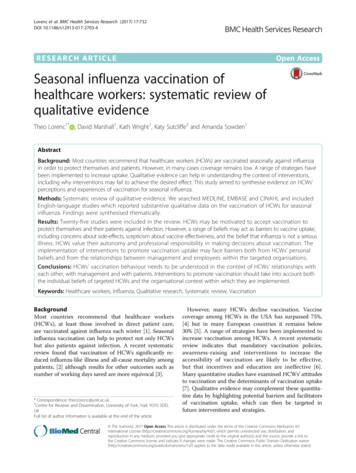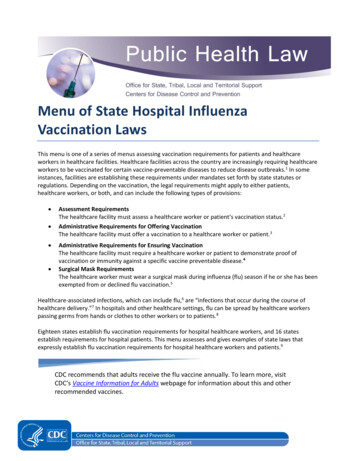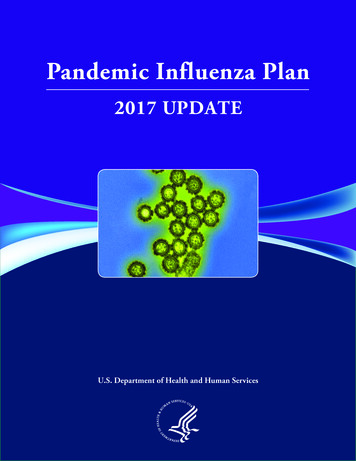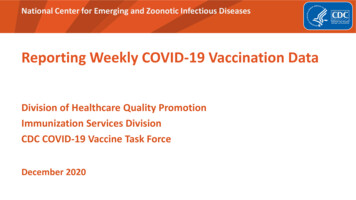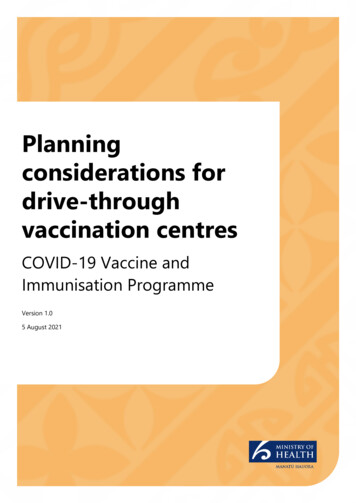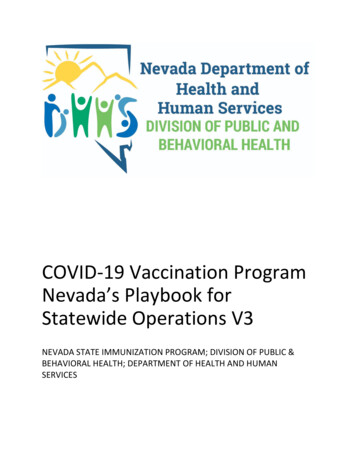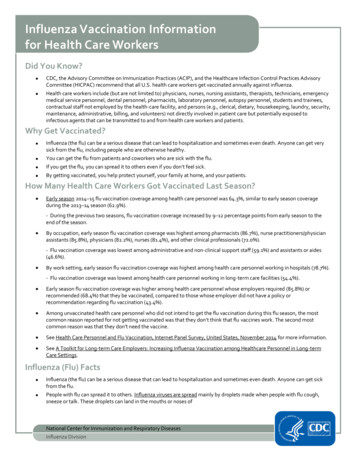
Transcription
Influenza Vaccination Informationfor Health Care WorkersDid You Know? CDC, the Advisory Committee on Immunization Practices (ACIP), and the Healthcare Infection Control Practices AdvisoryCommittee (HICPAC) recommend that all U.S. health care workers get vaccinated annually against influenza. Health care workers include (but are not limited to) physicians, nurses, nursing assistants, therapists, technicians, emergencymedical service personnel, dental personnel, pharmacists, laboratory personnel, autopsy personnel, students and trainees,contractual staff not employed by the health-care facility, and persons (e.g., clerical, dietary, housekeeping, laundry, security,maintenance, administrative, billing, and volunteers) not directly involved in patient care but potentially exposed toinfectious agents that can be transmitted to and from health care workers and patients.Why Get Vaccinated? Influenza (the flu) can be a serious disease that can lead to hospitalization and sometimes even death. Anyone can get verysick from the flu, including people who are otherwise healthy. You can get the flu from patients and coworkers who are sick with the flu. If you get the flu, you can spread it to others even if you don’t feel sick. By getting vaccinated, you help protect yourself, your family at home, and your patients.How Many Health Care Workers Got Vaccinated Last Season? Early season 2014–15 flu vaccination coverage among health care personnel was 64.3%, similar to early season coverageduring the 2013–14 season (62.9%).- During the previous two seasons, flu vaccination coverage increased by 9–12 percentage points from early season to theend of the season. By occupation, early season flu vaccination coverage was highest among pharmacists (86.7%), nurse practitioners/physicianassistants (85.8%), physicians (82.2%), nurses (81.4%), and other clinical professionals (72.0%).- Flu vaccination coverage was lowest among administrative and non-clinical support staff (59.1%) and assistants or aides(46.6%). By work setting, early season flu vaccination coverage was highest among health care personnel working in hospitals (78.7%).- Flu vaccination coverage was lowest among health care personnel working in long-term care facilities (54.4%). Early season flu vaccination coverage was higher among health care personnel whose employers required (85.8%) orrecommended (68.4%) that they be vaccinated, compared to those whose employer did not have a policy orrecommendation regarding flu vaccination (43.4%). Among unvaccinated health care personnel who did not intend to get the flu vaccination during this flu season, the mostcommon reason reported for not getting vaccinated was that they don’t think that flu vaccines work. The second mostcommon reason was that they don’t need the vaccine. See Health Care Personnel and Flu Vaccination, Internet Panel Survey, United States, November 2014 for more information. See A Toolkit for Long-term Care Employers: Increasing Influenza Vaccination among Healthcare Personnel in Long-termCare Settings.Influenza (Flu) Facts Influenza (the flu) can be a serious disease that can lead to hospitalization and sometimes even death. Anyone can get sickfrom the flu. People with flu can spread it to others. Influenza viruses are spread mainly by droplets made when people with flu cough,sneeze or talk. These droplets can land in the mouths or noses ofNational Center for Immunization and Respiratory DiseasesInfluenza Division
people who are up to about 6 feet away or possibly be inhaled into the lungs. Less often, a person might get flu by touching asurface or object that has flu virus on it and then touching their own mouth or nose. Most healthy adults may be able to infect others beginning 1 day before symptoms develop and up to 5 to 7 days afterbecoming sick. Children may pass the virus for longer. Symptoms start 1 to 4 days after the virus enters the body. That meansthat you may be able to pass on the flu to someone else before you know you are sick, as well as while you are sick. Somepersons can be infected with the flu virus but have no symptoms. During this time, those persons may still spread the virus toothers. Some people, such as older adults, pregnant women, and very young children as well as people with certain long-termmedical conditions are at high risk of serious complications from the flu. These medical conditions include chronic lungdiseases, such as asthma and chronic obstructive pulmonary disease (COPD), diabetes, heart disease, neurologic conditionsand pregnancy. Since health care workers may care for or live with people at high risk for influenza-related complications, it is especiallyimportant for them to get vaccinated annually. Annual vaccination is important because influenza is unpredictable, flu viruses are constantly changing and immunity fromvaccination declines over time. CDC recommends an annual flu vaccine as the first and best way to protect against influenza. This recommendation is thesame even during years when the vaccine composition (the viruses the vaccine protects against) remains unchanged from theprevious season.Flu Vaccine Facts The seasonal flu vaccine protects against the influenza viruses that research indicates will be most common during theupcoming season. Trivalent vaccines are made to protect against three flu viruses; an influenza A (H1N1) virus, an influenza A(H3N2) virus, and an influenza B virus. Quadrivalent vaccines protect against four viruses; the same viruses as the trivalentvaccine as well as an additional B virus. Flu vaccines CANNOT cause the flu. Flu vaccines are made with either killed or weakened viruses. Flu vaccines are safe. Serious problems from the flu vaccine are very rare. The most common side effect that a person islikely to experience is soreness where the injection was given. This is generally mild and usually goes away after a day or two.Visit Influenza Vaccine Safety for more information.Who Is Recommended for Vaccination?Everyone 6 months of age and older should get a flu vaccine every season. This recommendation has been in place since February 24,2010 when CDC’s Advisory Committee on Immunization Practices (ACIP) voted for “universal” flu vaccination in the United States toexpand protection against the flu to more people.Vaccination to prevent influenza is particularly important for people who are at high risk of serious complications from influenza. SeePeople at High Risk of Developing Flu-Related Complications for a full list of age and health factors that confer increased risk.More information is available at Who Should Get Vaccinated Against Influenza.Who Shouldn't Be Vaccinated?CDC recommends use of the flu shot (inactivated influenza vaccine or IIV) and the recombinant influenza vaccine (RIV). The nasal sprayflu vaccine (live attenuated influenza vaccine or LAIV) should not be used during 2016-2017. Different flu vaccines are approved for usein different groups of people. Factors that can determine a person's suitability for vaccination, or vaccination with a particular vaccine,include a person's age, health (current and past) and any allergies to flu vaccine or its components. People who cannot get a flu shot People who should talk to their doctor before getting the flu shotWhat Kinds of Seasonal Flu Vaccines Are Available?CDC recommends use of injectable influenza vaccines (including inactivated influenza vaccines and recombinant influenza vaccines)during 2016-2017. The nasal spray flu vaccine (live attenuated influenza vaccine or LAIV) should not be used during 2016-2017.Both trivalent (three-component) and quadrivalent (four-component) flu vaccines will be available.Trivalent flu vaccines include:
Standard-dose trivalent shots (IIV3) that are manufactured using virus grown in eggs. Different flu shots are approved fordifferent age groups. Most flu shots are given in the arm (muscle) with a needle. One trivalent vaccine formulation can begiven with a jet injector, for persons aged 18 through 64 years. A high-dose trivalent shot, approved for people 65 and older. A recombinant trivalent shot that is egg-free, approved for people 18 years and older. A trivalent flu shot made with adjuvant (an ingredient of a vaccine that helps create a stronger immune response in thepatient’s body), approved for people 65 years of age and older (new this season).Quadrivalent flu vaccines include: Quadrivalent flu shots approved for use in different age groups. An intradermal quadrivalent flu shot, which is injected into the skin instead of the muscle and uses a much smaller needlethan the regular flu shot. It is approved for people 18 through 64 years of age. A quadrivalent flu shot containing virus grown in cell culture, which is approved for people 4 years of age and older (new thisseason).How Do Flu Vaccines Work?The seasonal flu vaccine protects against the influenza viruses research indicates will be most common during the upcoming season.Antibodies develop in the body about two weeks after vaccination. These antibodies provide protection against infection from virusesthat are the same as or similar to those used to make the vaccine.What Viruses Does the 2016-2017 Vaccine Provide Protection Against?All 2016-2017 influenza vaccines are made to protect against the following three viruses: an A/California/7/2009 (H1N1)pdm09-like virus an A/Hong Kong/4801/2014 (H3N2)-like virus a B/Brisbane/60/2008-like virus. (This is a B/Victoria lineage virus)Some of the 2016-2017 flu vaccine is quadrivalent vaccine and also protects against an additional B virus (B/Phuket/3073/2013-likevirus). This is a B/Yamagata lineage virus.Vaccines that give protection against three viruses are called trivalent vaccines. Vaccines that give protection against four viruses arecalled quadrivalent vaccines.More information about influenza vaccines is available at Preventing Seasonal Flu With Vaccination.If I Got Vaccinated During the 2015-2016 Season, Do I Need to Get VaccinatedThis Season?Yes. CDC recommends a yearly flu vaccine for everyone 6 months and older. This is for two reasons: vaccine compositions may beupdated from one season to the next and a person's immune protection from vaccination declines over time. So an annual vaccinationis needed to get the “optimal” or best protection against the flu.When Should I Get Vaccinated?Optimally, vaccination should occur before onset of influenza activity in the community. Health care providers should offer vaccinationby the end of October, if possible. Vaccination should continue to be offered as long as influenza viruses are circulating. While seasonalinfluenza outbreaks can happen as early as October, most of the time influenza activity peaks between December and February. Sinceit takes about two weeks after vaccination for antibodies to develop in the body that protect against influenza virus infection, it is bestthat people get vaccinated so they are protected before influenza begins spreading in their community.Protect yourself, your family, and your patients by getting a flu vaccine this season.What Is CDC’s Position on Mandating Flu Vaccination for Health Care Workers?The findings of a recent CDC review of related published literature indicate that influenza vaccination of health care personnel canenhance patient safety. 1,2
CDC conducts science-based investigations, research, and public health surveillance both nationally and internationally. CDC adoptsrecommendations that are made by the Advisory Committee for Immunization Practices. These recommendations may be consideredby state and other Federal agencies when making or enforcing laws. CDC also has infection control recommendations for health caresettings. However, CDC does not issue any requirements or mandates for state agencies, health systems, or health care workersregarding infection control practices, including influenza vaccination or the use of masks.However, some employers require certain immunizations. Hospitals, for example, may require some staff to get the flu vaccine orhepatitis B vaccine or take other precautions such as the use of masks.To find out more about the laws in your state, contact your state health department through Public Health Resources: State HealthDepartments.State Immunization Laws for Healthcare Workers and Patients and Vaccines and Immunizations: Basics and Common QuestionsNational Center for Immunization and Respiratory Diseases have more information. For more information, updates, and access to freematerials to assist with educating staff and patients about the impact of influenza and the benefits of vaccination, visit CDC SeasonalInfluenza (Flu) or call the National Immunization Hotline at (800) 232-2522 (English), (800) 232-0233 (español), or (800) 243-7889 (TTY).Special Consideration Regarding Egg AllergyThe recommendations for vaccination of people with egg allergies have changed for 2016-2017.People with egg allergies can receive any licensed, recommended age-appropriate influenza vaccine and no longer have to bemonitored for 30 minutes after receiving the vaccine. People who have severe egg allergies should be vaccinated in a medical settingand be supervised by a health care provider who is able to recognize and manage severe allergic conditions.More InformationInfluenza Vaccination Coverage Among Health Care Personnel — United States, 2013–14 Influenza Season. MMWR Morb Mortal WklyRep 2014;63:805-11Influenza Vaccination Performance Measurement Among Acute Care Hospital-Based Health Care Personnel — United States, 2013–14Influenza Season. MMWR Morb Mortal Wkly Rep 2014; 63:812-5Health Care Personnel and Flu Vaccination, Internet Panel Survey, United States, November, 2013Influenza Vaccination Coverage Among Health-Care Personnel — United States, 2012–13 Influenza Season. MMWR Morb Mortal WklyRep 2013;62(38);781-7861Ahmed F, Lindley M, Allred N, Weinbaum C, Grohskopf L. Effect of Influenza Vaccination of Health Care Personnel on Morbidity andMortality Among Patients: Systematic Review and Grading of Evidence. Clin Infect Dis 2013; epublished ahead of print.2Griffin MR. Influenza Vaccination of Health Care Workers: Making the Grade for Action. Clin Infect Diseases 2013; epublished aheadof print.Thomas RE, Jefferson T, Lasserson TJ. Influenza vaccination for healthcare workers who care for people aged 60 or older living in longterm care institutions. Cochrane Database of Systematic Reviews 2013, Issue 7. Art. No.: CD005187. DOI:10.1002/14651858.CD005187.pub4.Health Care Personnel Flu Vaccination, Internet Panel Survey, United States, November, 2012CDC. Influenza Vaccination Coverage Among Health-Care Personnel – 2011-12 Influenza Season, United States. MMWR 2012:61:753757.CDC COCA Conference Call. Update on Influenza Vaccination for Health Care Personnel: Recent Coverage, Recommendations,Reporting, and Resources. November 15, 2011.CDC. Influenza Vaccination Coverage Among Health-Care Personnel—United States, 2010-11 Influenza Season. MMWR 2011;60:10731077.CDC. Telebriefing on Influenza Vaccination Among Health Care Personnel and Pregnant Women. Thursday, August 18, 2011.Vanhems P, Voirin N, Roche S, Escuret V, Regis C et al. Risk of influenza-like illness in an acute health care setting during communityinfluenza epidemics in 2004-2005, 2005-2006, and 2006-2007: a prospective study. Arch Intern Med 2011; 171(2);151-17.
CDC. Prevention and control of influenza with vaccines. Recommendations of the Advisory Committee on Immunization Practices(ACIP), 2010. MMWR 2010;59(No. RR-8).Apisarnthanarak A, Uyeki T, Puthavathana P, Kitphati R, Mundy L. Reduction of seasonal influenza transmission among healthcareworkers in an intensive care unit: A 4-year intervention study in Thailand. Infect Control Hosp Epidemiol 2010; 31(10);996-1003.Turnberg W, Daniell W, Duchin J. Influenza vaccination and sick leave practices and perceptions reported by health care workers inambulatory care settings. Am J Infect Control 2010; 38(6):486-8.CDC. Influenza vaccination of health-care personnel: recommendations of the Healthcare Infection Control Practices AdvisoryCommittee (HICPAC) and the Advisory Committee on Immunization Practices (ACIP). MMWR 2006;55(No. RR-2).Salgado CD, Giannetta ET, Hayden FG, Farr BM. Preventing nosocomial influenza by improving the vaccine acceptance rate ofclinicians. Infect Control Hosp Epidemiol 2004;25:923--8.Saito R, Suzuki H, Oshitani H, Sakai T, Seki N, Tanabe N. The effectiveness of influenza vaccine against influenza A (H3N2) virusinfections in nursing homes in Niigata, Japan, during the 1998--1999 and 1999--2000 seasons. Infect Control Hosp Epidemiol2002;23:82--6.Cunney RJ, Bialachowski A, Thornley D, Smaill FM, Pennie RA. An outbreak of influenza A in a neonatal intensive care unit. InfectControl Hosp Epidemiol 2000;21:449--54.WF, Elder AG, Wallace LA, et al. Effects of influenza vaccination of health-care workers on mortality of elderly people in long-termcare: a randomised controlled trial. Lancet 2000;355(9198): 93--7.Saxen H, Virtanen M. Randomized, placebo-controlled double blind study on the efficacy of influenza immunization on absenteeism ofhealth care workers. Pediatr Infect Dis J 1999;18:779--83.Wilde JA, McMillan JA, Serwint J, Butta J, O'Riordan MA, Steinhoff MC. Effectiveness of influenza vaccine in health care professionals:a randomized trial. JAMA 1999;281:908--13.Potter J, Stott DJ, Roberts MA, et al. Influenza vaccination of health care workers in long-term-care hospitals reduces the mortality ofelderly patients. J Infect Dis 1997;175:1--6.Last reviewed: August 25, 2016Last updated: November 1, 2016
Standard-dose trivalent shots (IIV3) that are manufactured using virus grown in eggs. Different flu shots are approved for different age groups. Most flu shots are given in the arm (muscle) with a needle. One trivalent vaccine formulation can be given with a jet injector, for persons aged 18 through 64 years.
